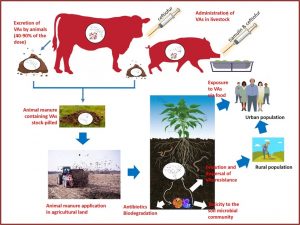Veterinary antibiotics (VAs) and anthelmintics (AHs) are used to control microbial and parasitic infestations in livestock farming respectively. These compounds are not metabolized in the animals' body and are excreted at copious amounts in animal feces. These are further used as manures in agricultural soils facilitating the dispersal of VA and AHs in the environment. This imposes significant pressure in the soil microbial community for selection and further dispersal of resistant traits for VAs and constitutes a threat for water quality since VAs and AHs could move from soil to aquifers threatening environmental homeostasis. We only just starting to understand the mechanisms driving the interactions between veterinary drugs and the soil microbiota, the factors determining the outcome of these interactions which could span from biodegradation to toxicity. To date little is known about the biodegradation of these veterinary drugs. It was recently shown that the continuous soil exposure to sulfonamides and macrolides could select for resistance and for VA-degrading traits. Only a few VA-degrading bacteria have been isolated while nothing is known about the bacteria degrading AHs in soil. Bacteria carrying biodegradation traits against these veterinary drugs could be exploited for the bioaugmentation of contaminated manures and soils, minimizing environmental pressure.

The route of veterinary drugs from livestock farms to the agricultural soil and the environment and implications for environmental quality and human health.
Our group explores the complex interactions of veterinary drugs with soil microorganisms, look into evolutionary mechanisms that drive the selection (antibiotic resistance vs biodegradation traits) and exploit biodegradation to avert environmental threats by VAs and AHs.
Collaborators: Our group is working closely with the group of Dr Smaragda Sotiraki, HAO-Demeter, Institute of Veterinary Research, Thessaloniki, Greece.
Funding
 Call of ELIDEK for the support of PhD students, Title: The biodegradation of veterinary drugs as a mean to prevent and avert environmental degradation. Funding Body: Hellenic Foundation for Research and Innovation (ELIDEK), Greece. Duration: 2019-2022, Benefited Student: Stathis Lagos. Supervisor: Dimitrios Karpouzas
Call of ELIDEK for the support of PhD students, Title: The biodegradation of veterinary drugs as a mean to prevent and avert environmental degradation. Funding Body: Hellenic Foundation for Research and Innovation (ELIDEK), Greece. Duration: 2019-2022, Benefited Student: Stathis Lagos. Supervisor: Dimitrios Karpouzas
![]() Call EDBM of small projects for the support of young researchers, Title: Environmental fate and interactions of veterinary antibiotics ceftiofur and tiamulin with the soil microbial community: Resistance, biodegradation or ecotoxicity?, Funding Body: Hellenic Ministry of Education, Greece. Duration: 2019-2020. Coordinator: Dimitris Karpouzas
Call EDBM of small projects for the support of young researchers, Title: Environmental fate and interactions of veterinary antibiotics ceftiofur and tiamulin with the soil microbial community: Resistance, biodegradation or ecotoxicity?, Funding Body: Hellenic Ministry of Education, Greece. Duration: 2019-2020. Coordinator: Dimitris Karpouzas
 Call of HFRI for Postdoctoral Fellows, Title: INteractions of Veterinary antibiotics with soil microorganisms: exploiting microbial degradation to avert Environmental contamination and ResisTance dispersal (INVERT). Funding Body: Hellenic Foundation for Research and Innovation. Funding: 175000 €, Duration: 2021-2023. Coordinator: S. Vasileiadis
Call of HFRI for Postdoctoral Fellows, Title: INteractions of Veterinary antibiotics with soil microorganisms: exploiting microbial degradation to avert Environmental contamination and ResisTance dispersal (INVERT). Funding Body: Hellenic Foundation for Research and Innovation. Funding: 175000 €, Duration: 2021-2023. Coordinator: S. Vasileiadis
Publications
- Lagos S., Perruchon C., Tsikriki, A., Gourombinos E., Vasileiadis S., Sotiraki S., Karpouzas D.G., (2021) Bioaugmentation of animal feces as a mean to mitigate environmental contamination with anthelmintic benzimidazoles. Journal of Hazardous Materials https://doi.org/10.1016/j.jhazmat.2021.126439
- Lagos S., Moutzoureli C., Spiropoulou I., Karas P.A., Saratsis A., Sotiraki S., Karpouzas D.G., (2021) Biodegradation of anthelmintics in soils: Does prior exposure of soils to anthelmintics accelerate their dissipation? submitted
Personnel
Dr Chiara Perruchon, Postdoc Fellow
Stathis Lagos, PhD student
Eleni Katsivelou, PhD student